The world of e-commerce is a dynamic landscape where businesses thrive on innovation, user experience, and effective marketing strategies. In this blog, we’ll explore the essential elements of e-commerce marketing, from building a robust online presence to leveraging cutting-edge strategies that drive traffic, engage customers, and boost sales.
I. The Foundation of E-commerce Marketing

A. Understanding E-commerce Marketing
E-commerce marketing involves promoting products or services online with the goal of driving sales. It encompasses a range of activities, from optimizing product pages to implementing digital advertising strategies.
B. The Impact of E-commerce on Business
E-commerce has transformed the retail landscape, offering businesses the opportunity to reach a global audience, operate 24/7, and create personalized shopping experiences.
II. Building a Strong Online Presence
A. User-Friendly Website Design
A seamless and user-friendly website is the cornerstone of successful e-commerce. Intuitive navigation, clear product categorization, and a secure checkout process enhance the overall user experience.
B. Mobile Optimization
With a significant portion of online traffic coming from mobile devices, ensuring a mobile-responsive website is essential. Mobile optimization improves accessibility and enhances user satisfaction.
III. Product Optimization and Presentation
A. High-Quality Visuals
Compelling visuals are crucial in e-commerce. High-resolution images, product videos, and 360-degree views provide customers with a comprehensive understanding of the products.
B. Clear Product Descriptions
Detailed and accurate product descriptions are vital for informing customers about features, benefits, and specifications. Transparency fosters trust and diminishes the probability of returns.
IV. Implementing E-commerce SEO Strategies
A. Keyword Optimization
Strategic use of relevant keywords in product titles, descriptions, and metadata enhances visibility in search engine results, attracting organic traffic.
B. User-Generated Content
Encouraging customers to leave reviews and share their experiences generates user-generated content that not only serves as social proof but also boosts SEO.
V. E-commerce Content Marketing
A. Blogging and Educational Content
Creating a blog or educational content related to products helps establish authority in the industry, improves SEO, and provides added value to customers.
B. Email Marketing
Targeted email campaigns, including newsletters, product announcements, and exclusive offers, nurture customer relationships and drive repeat business.
VI. Social Media for E-commerce
A. Social Media Advertising
Paid advertising on platforms like Facebook, Instagram, and Pinterest allows businesses to target specific demographics, increasing brand visibility and driving traffic.
B. Social Commerce
Integrating shopping features directly into social media platforms enables users to make purchases without leaving the app, streamlining the buying process.
VII. E-commerce Analytics and Data-driven Decisions
A. Utilizing Analytics Tools
E-commerce analytics provide valuable insights into customer behavior, preferences, and the effectiveness of marketing efforts. Data-driven decisions optimize strategies for better results.
B. A/B Testing
Experimenting with different elements, such as website layouts, product images, or advertising copy, through A/B testing helps identify the most effective approaches.
VIII. E-commerce Customer Retention
A. Loyalty Programs
Implementing loyalty programs, offering discounts, and providing exclusive access to promotions incentivize repeat purchases and foster customer loyalty.
B. Exceptional Customer Service
Responsive customer service, including live chat, clear communication, and efficient problem resolution, enhances the overall shopping experience.
IX. E-commerce Trends and Innovations
A. Emerging Technologies
Keeping abreast of emerging technologies, such as augmented reality (AR) for virtual try-ons or artificial intelligence (AI) for personalized recommendations, adds a competitive edge.
B. Sustainability and Ethical Practices
Consumers increasingly value sustainability. Incorporating eco-friendly practices and transparent sourcing into marketing messages can resonate positively with the audience.
X. Conclusion
E-commerce marketing is a multifaceted endeavor that requires a holistic approach. From optimizing the online store for user experience to implementing advanced marketing strategies, businesses must adapt to the ever-evolving landscape to stay competitive and meet customer expectations.

